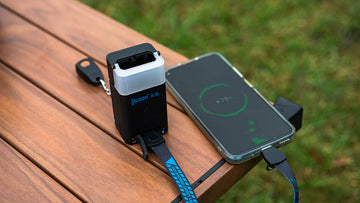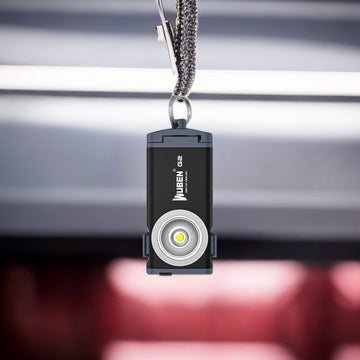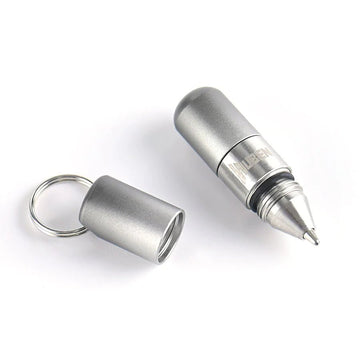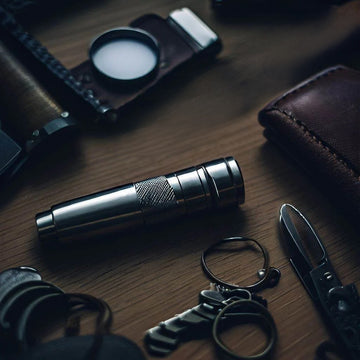
In the world of everyday carry gear, one item stands out as essential - the everyday carry flashlight. A compact and versatile illumination tool, an everyday carry flashlight is a must-have for anyone seeking preparedness and convenience. Here, we will delve into the significance of incorporating a flashlight into your everyday carry gear and explore the factors to consider when choosing the right one for your needs.
Size and Portability: The beauty of an everyday carry flashlight lies in its compactness. Look for a flashlight that is small enough to comfortably fit in your pocket or attach to your keychain, ensuring easy carry without weighing you down.
Battery Type and Runtime: Power source and runtime are critical factors to consider. Evaluate the battery type supported by the flashlight and determine the runtime it offers. Opt for a flashlight that strikes a balance between power efficiency and longevity.
A daily carry flashlight should be able to resist normal wear and tear. Durability and build quality. Choose flashlights that are built of sturdy materials like aerospace-grade aluminum or robust plastics. Additionally, consider features like impact resistance and reinforced construction to ensure the flashlight can handle accidental drops or rough handling.
User-Friendly Features: Flashlights come with a range of features to enhance usability. Look for flashlights that offer multiple lighting modes, such as high, low, strobe, or SOS, to adapt to different situations. Additionally, consider flashlights with user-friendly controls and interfaces for easy operation, even in high-stress situations.
Your regular carry flashlight should be able to handle challenging circumstances. It should be waterproof and impact resistant. Look for flashlights with an IPX certification, which denotes how waterproof they are. This ensures that the flashlight can handle rain, splashes, or even submersion in water to a certain depth. Additionally, consider flashlights that are impact resistant, as they are built to endure rough environments and accidental drops.
Tactical Flashlight: Built for versatility and ruggedness, tactical flashlights are designed for demanding situations. They often feature high lumen outputs, durable construction, and specialized features like strobe modes and crenulated bezels for self-defense purposes.
Penlight: With a slim and elongated design resembling a pen, penlights are discreet and versatile lighting options. They are compact enough to fit in a pocket or be clipped onto a shirt, making them convenient for daily use or emergencies.
Headlamp: Perfect for hands-free illumination, headlamps are commonly used during outdoor activities such as camping, hiking, or working in low-light conditions. They are worn on the head, providing a reliable light source without the need to hold a flashlight.
Pocket-Sized Flashlight: These flashlights strike a balance between portability and performance. They are compact enough to be comfortably carried in a pocket or attached to a belt, while still providing sufficient brightness for everyday tasks.
Best Practices for Using an Everyday Carry Flashlight
Familiarize Yourself with the Controls: Before relying on your everyday carry flashlight, take the time to understand its functionality. Learn how to adjust brightness levels, switch between modes, and activate any special features it may have. Practicing with your flashlight beforehand will ensure you can quickly and efficiently use it when needed.
Practice Proper Battery Management: To maximize the runtime of your everyday carry flashlight, adopt good battery management practices. Keep spare batteries on hand, regularly check the battery level, and replace them as needed. Avoid leaving depleted batteries in the flashlight, as this can lead to leakage or damage.
Adjusting Light Modes for Different Scenarios: Different situations call for different lighting requirements. Learn how to adjust the brightness and modes of your flashlight to adapt to the task at hand. Utilize a lower brightness setting for tasks that require close-up precision, and switch to a higher brightness mode for increased visibility in dark environments.
Regular Maintenance and Inspection: Like any tool, your everyday carry flashlight requires regular maintenance. Periodically clean dirt or debris from the flashlight's lens and body to improve performance. Inspect the O-rings and seals to ensure they are intact and free from damage, as these components play a crucial role in keeping the flashlight waterproof.
Utilizing Tactical Features: If your everyday carry flashlight has tactical features, such as a strobe mode or a crenulated bezel, familiarize yourself with its functionality. These features can be useful for self-defense or emergency signaling, but remember to use them responsibly and within legal limits.
Complementing Other EDC Items: Your everyday carry gear should work together harmoniously. Consider how your flashlight can complement other EDC items in terms of functionality and preparedness. For example, pairing your flashlight with a multitool can provide a versatile toolset for various situations.
Personalization and Aesthetic Considerations: While functionality is crucial, personalization and aesthetics can also play a role in your choice of an everyday carry flashlight. Many flashlights offer customization options, such as different color finishes or patterns. Select a flashlight that aligns with your style and preferences, making it an extension of your identity.
Selecting Compatible Accessories: Enhance the functionality and versatility of your everyday carry flashlight by selecting compatible accessories. This may include diffusers or filters for different lighting needs, lanyards or paracord attachments for added security, or pocket clips for easy attachment to clothing or gear.
Being Mindful of Beam Intensity: Flashlight beams can be intense, and shining them directly into someone's eyes can cause discomfort and temporary vision impairment. Be mindful of where you point your flashlight to prevent accidental blinding. Adjust the beam intensity or angle accordingly, especially near others.
Properly Handling and Storing Batteries: Batteries are an essential component of your everyday carry flashlight, but they require proper handling and storage to mitigate potential risks. Use high-quality batteries from reputable brands, follow manufacturer instructions for installation, and avoid mixing different battery types. When storing spare batteries, use dedicated battery cases or keep them separate from loose objects to prevent short-circuiting.
That's all, an everyday carry flashlight is a versatile and practical tool that should be a part of every individual's EDC gear. You may select the ideal flashlight to suit your demands by taking into account elements like brightness, size, battery type, durability, and user-friendly features.
Whether it's a compact keychain flashlight or a rugged tactical flashlight, incorporating this essential tool into your everyday carry setup ensures you are always prepared for various situations. Remember to practice proper maintenance, familiarize yourself with the controls, and adhere to safety and etiquette guidelines when using your everyday carry flashlight. Stay prepared, stay illuminated, and stay confident with the right everyday carry flashlight by your side.
Factors to Consider
Brightness and Output: When it comes to flashlights, brightness is paramount. A flashlight's brightness is expressed in lumens, and a greater lumen value indicates a more visible beam. Choose an appropriate brightness setting based on the flashlight's intended use and your needs.Size and Portability: The beauty of an everyday carry flashlight lies in its compactness. Look for a flashlight that is small enough to comfortably fit in your pocket or attach to your keychain, ensuring easy carry without weighing you down.
Battery Type and Runtime: Power source and runtime are critical factors to consider. Evaluate the battery type supported by the flashlight and determine the runtime it offers. Opt for a flashlight that strikes a balance between power efficiency and longevity.
A daily carry flashlight should be able to resist normal wear and tear. Durability and build quality. Choose flashlights that are built of sturdy materials like aerospace-grade aluminum or robust plastics. Additionally, consider features like impact resistance and reinforced construction to ensure the flashlight can handle accidental drops or rough handling.
User-Friendly Features: Flashlights come with a range of features to enhance usability. Look for flashlights that offer multiple lighting modes, such as high, low, strobe, or SOS, to adapt to different situations. Additionally, consider flashlights with user-friendly controls and interfaces for easy operation, even in high-stress situations.
Your regular carry flashlight should be able to handle challenging circumstances. It should be waterproof and impact resistant. Look for flashlights with an IPX certification, which denotes how waterproof they are. This ensures that the flashlight can handle rain, splashes, or even submersion in water to a certain depth. Additionally, consider flashlights that are impact resistant, as they are built to endure rough environments and accidental drops.
Types and Designs
Keychain Flashlight: These compact and lightweight flashlights are designed to be attached to your keychain, ensuring that you always have a source of light readily available. Despite their small size, keychain flashlights can provide impressive brightness and functionality.Tactical Flashlight: Built for versatility and ruggedness, tactical flashlights are designed for demanding situations. They often feature high lumen outputs, durable construction, and specialized features like strobe modes and crenulated bezels for self-defense purposes.
Penlight: With a slim and elongated design resembling a pen, penlights are discreet and versatile lighting options. They are compact enough to fit in a pocket or be clipped onto a shirt, making them convenient for daily use or emergencies.
Headlamp: Perfect for hands-free illumination, headlamps are commonly used during outdoor activities such as camping, hiking, or working in low-light conditions. They are worn on the head, providing a reliable light source without the need to hold a flashlight.
Pocket-Sized Flashlight: These flashlights strike a balance between portability and performance. They are compact enough to be comfortably carried in a pocket or attached to a belt, while still providing sufficient brightness for everyday tasks.
Best Practices for Using an Everyday Carry Flashlight
Familiarize Yourself with the Controls: Before relying on your everyday carry flashlight, take the time to understand its functionality. Learn how to adjust brightness levels, switch between modes, and activate any special features it may have. Practicing with your flashlight beforehand will ensure you can quickly and efficiently use it when needed.
Practice Proper Battery Management: To maximize the runtime of your everyday carry flashlight, adopt good battery management practices. Keep spare batteries on hand, regularly check the battery level, and replace them as needed. Avoid leaving depleted batteries in the flashlight, as this can lead to leakage or damage.
Adjusting Light Modes for Different Scenarios: Different situations call for different lighting requirements. Learn how to adjust the brightness and modes of your flashlight to adapt to the task at hand. Utilize a lower brightness setting for tasks that require close-up precision, and switch to a higher brightness mode for increased visibility in dark environments.
Regular Maintenance and Inspection: Like any tool, your everyday carry flashlight requires regular maintenance. Periodically clean dirt or debris from the flashlight's lens and body to improve performance. Inspect the O-rings and seals to ensure they are intact and free from damage, as these components play a crucial role in keeping the flashlight waterproof.
Utilizing Tactical Features: If your everyday carry flashlight has tactical features, such as a strobe mode or a crenulated bezel, familiarize yourself with its functionality. These features can be useful for self-defense or emergency signaling, but remember to use them responsibly and within legal limits.
Integrating an Everyday Carry Flashlight into Your EDC Gear
Accessibility and Carry Options: When it comes to incorporating an everyday carry flashlight into your EDC setup, accessibility is key. Choose a carry option that allows for quick and easy access to your flashlight when needed. Options include attaching it to a keychain, clipping it to a pocket or belt, or using a dedicated flashlight pouch or organizer.Complementing Other EDC Items: Your everyday carry gear should work together harmoniously. Consider how your flashlight can complement other EDC items in terms of functionality and preparedness. For example, pairing your flashlight with a multitool can provide a versatile toolset for various situations.
Personalization and Aesthetic Considerations: While functionality is crucial, personalization and aesthetics can also play a role in your choice of an everyday carry flashlight. Many flashlights offer customization options, such as different color finishes or patterns. Select a flashlight that aligns with your style and preferences, making it an extension of your identity.
Selecting Compatible Accessories: Enhance the functionality and versatility of your everyday carry flashlight by selecting compatible accessories. This may include diffusers or filters for different lighting needs, lanyards or paracord attachments for added security, or pocket clips for easy attachment to clothing or gear.
Safety and Etiquette
Avoiding Unnecessary Use: While an everyday carry flashlight is a handy tool, it's important to use it responsibly and avoid unnecessary or intrusive use. Respect others' privacy and comfort by using your flashlight only when necessary and in appropriate settings.Being Mindful of Beam Intensity: Flashlight beams can be intense, and shining them directly into someone's eyes can cause discomfort and temporary vision impairment. Be mindful of where you point your flashlight to prevent accidental blinding. Adjust the beam intensity or angle accordingly, especially near others.
Properly Handling and Storing Batteries: Batteries are an essential component of your everyday carry flashlight, but they require proper handling and storage to mitigate potential risks. Use high-quality batteries from reputable brands, follow manufacturer instructions for installation, and avoid mixing different battery types. When storing spare batteries, use dedicated battery cases or keep them separate from loose objects to prevent short-circuiting.
That's all, an everyday carry flashlight is a versatile and practical tool that should be a part of every individual's EDC gear. You may select the ideal flashlight to suit your demands by taking into account elements like brightness, size, battery type, durability, and user-friendly features.
Whether it's a compact keychain flashlight or a rugged tactical flashlight, incorporating this essential tool into your everyday carry setup ensures you are always prepared for various situations. Remember to practice proper maintenance, familiarize yourself with the controls, and adhere to safety and etiquette guidelines when using your everyday carry flashlight. Stay prepared, stay illuminated, and stay confident with the right everyday carry flashlight by your side.
Related Articles




